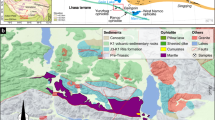Abstract
The classical models of adakite formation by melting of basaltic layer of oceanic lithosphere in the subduction zone were verified using geochemical and Sr–Nd isotope data on the Early Paleozoic granitoids of Eastern Sayan. The presence of adakites in fold belts is usually regarded as geochemical proxy for paleogeodynamic reconstruction. The formation of felsic derivatives with adakitic signatures in the collisional orogens is inconsistent with these models and requires their revision. It is shown that the composition of the granitoids and their evolution cannot be described with these models. In order to solve this problem, two hypotheses of granitoid formation by mixing of two geochemically contrasting reservoirs were proposed and verified. According to the first hypothesis, the granitoids represent the mixing products between alkaline olivine basalts and partial melts of the gray gneiss basement of this region. The second model relates the formation of the granitoids with melting of geochemically 2700 Ma-old enriched source in the subcontinental lithospheric mantle. In spite of differences, both these hypotheses are based on the remobilization of sources formed at the previous stages of the geological evolution of the region. In both cases, adakitic geochemical characteristics of forming felsic magmas are determined by the composition of protolith rather than by their geodynamic position. Obtained preliminary results place constraints on genetic models and geochemical reservoirs participating in the formation of the granitoids.
Similar content being viewed by others
References
I. V. Anisimova, I. V. Levitsky, E. B. Sal’nikova, A. B. Kotov, L. Z. Reznitsky, S. V. Efremov, S. D. Velikoslavinsky, I.G. Barash, and A. M. Fedoseenko, “Age of the basement of the Gargan block (Eastern Sayan): results of U-Pb geochronological studies,” in Isotopic Systems and Timingof Geological Processes (IGGD RAS, St. Petersburg, 2009), pp. 34–35 [in Russian].
V. P. Arsent’ev, and A. R. Zilov, “Some data on the granite intrusion of the Munky-Sardyk Range, East Sayan,” Sb. Geol.-Proizovdstv. Inform., No. 3, 17–28 (1959).
I. G. Barash, L. Z. Reznitsky, V. G. Belichenko, E. B. Sal’nikova, and A. B. Kotov, “Munku–Sardyk granitoid complex as indicator complex,” in Geodynamic Evolution of the Lithosphere of the Central Asian Mobile Belt (ISK SO RAN, Irkutsk, 2005), pp. 23–26 [in Russian].
I. V. Chernyshev, K. N. Shatagin, and Yu. V. Gol’tsman, “High-precision calibration of strontium isotope standards on multicollector mass spectrometer,” Geochem. Int. 38 (12), 1175–1180 (2000).
M. J. Defant and M. S. Drummond, “Derivation of some modern arc magmas by melting of young subducted lithosphere,” Nature 347, 662–665 (1990).
A. P. Dickin, Radiogenic Isotope Geology (Cambridge University Press, 2005).
S. V. Efremov, “The main reasons for the compositional evolution of the Early Paleozoic granitoids of the Eastern Sayan: evidence from the Munku-Sardyk Massif,” Geochem. Int. 47 (3), 268–281 (2009a).
S. V. Efremov, “Adakite magmatism in the Eastern Sayan: genetic features and sources,” Geochem. Int. 47 (11), 1148–1153 (2009b).
S. V. Efremov, “Early Paleozoic adakites in the Eastern Sayan: geochemistry and sources,” Geochem. Int. 48 (11), 1112–1127 (2010).
S. Foley, “Vein-plus-wall-rock melting mechanisms in the lithosphere and the origin of potassic alkaline magmas,” Lithos 28, 435–453 (1992). Geochemical Earth Reference Model//http://earthref.org/GERM/
R. W. Kay, “Aleutian magnesian andesites: melts from subducted Pacific Ocean crust,” J. Volcanol. Geotherm. Res. 4, 117–132 (1978).
A. B. Kotov, E. B. Sal’nikova, L. Z. Reznitskii, E. P. Vasil’ev, I. K. Kozakov, S. Z. Yakovleva, V. P. Kovach, and N. G. Berezhnaya, “Age of metamorphism of the Slyudyanka Crystalline complex, Southern Baikal area: U-Pb geochronology of granitoids,” Petrology 5 (4), 338–349 (1997).
H. Martin, “Adakitic magmas: modern analogues of Archaean granitoids,” Lithos 46, 411–429 (1999).
H. Martin, R. H. Smithies, R. Rapp, J.-F. Moyen, and D. Champion, “An overview of adakite, tonalite–trondhjemite–granodiorite (TTG), and sanukitoid: relationships and some implications for crustal evolution,” Lithos 79, 1–24 (2005).
Th. F. Nagler and J. D. Kramers, “Nd isotopic evolution of the upper mantle during the Precambrian: models, data and the uncertainty of both,” Precambrian Res. 91, 233–252 (1998).
A. V. Nikiforov and V. V. Yarmolyuk, “Early Paleozoic age and geodynamic setting of the Botogol and Khushagol alkaline massifs in the Central Asian Foldbelt,” Dokl. Earth Sci. 412 (1), 6–10 (2007).
Y. Orihasi, J. Maeda, K. Niida, and S. Jshinara, “Analysis of Nd isotope ratio for the GSJ reference sample JNdi-1,” Earth Planet. Mater. Sci., Technical Report (Hokkaido University, Sapporo, 1997), pp. 1–17.
X-M. Qu, Z-Q. Hou, and Y-G. Li “Melt components derived from a subducted slab in late orogenic ore bearing porphyries in the Gangdese copper belt, southern Tibetan plateau,” Lithos 74, 131–148 (2004).
R. P. Rapp and E. B. Watson, “Dehydratation melting of metabasalt at 8–32 kbar: implications for continental growth and crust-mantle recycling,” J. Petrol. 36, 891–931 (1995).
L. Z. Reznitskii, E. B. Sal’nikova, I. G. Barash, V. G. Belichenko, V. A. Glebovitskii, A. B. Kotov, V. P. Kovach, S. Z. Yakovleva, and A. M. Fedoseenko, “Upper age boundary of the accretion of terranes in the northwestern part of the eastern segment of the Central Asian Foldbelt,” Dokl. Earth Sci. 414 (4), 548–551 (2007).
F. G. Sajona, R. C. Mauri, M. Pubellier, J. Leterrier, H. Bellon, and J. Cotton, “Magmatic source enrichment by slab-derived melts in young post-collision setting, central Mindango (Philippines),” Lithos 54, 173–206 (2000).
Wang, Q. Jian Ping, Zhi-Wei Bao, Ji-Feng Xu, and Chao-Feng Li, “Petrogenesis of adakitic porphyries in an extensional tectonic setting, Dexing, South China: implications for the genesis of porphyry copper mineralization,” J. Petrol. 47 (1), 119–144 (2006).
Author information
Authors and Affiliations
Corresponding author
Additional information
Original Russian Text © S.V. Efremov, S.I. Dril’, G.P. Sandimirova, 2016, published in Geokhimiya, 2016, No. 7, pp. 633–640.
Rights and permissions
About this article
Cite this article
Efremov, S.V., Dril’, S.I. & Sandimirova, G.P. Formation of adakitic granitoids in the collisional orogens: Evidence from the Early Paleozoic granitoids of the Munku–Sardyk Range, Eastern Sayan. Geochem. Int. 54, 618–623 (2016). https://doi.org/10.1134/S0016702916070028
Received:
Accepted:
Published:
Issue Date:
DOI: https://doi.org/10.1134/S0016702916070028




